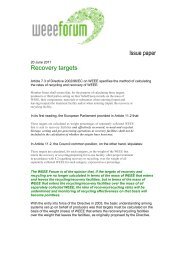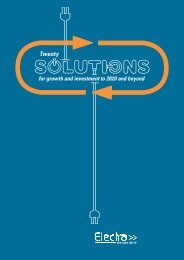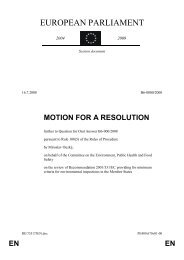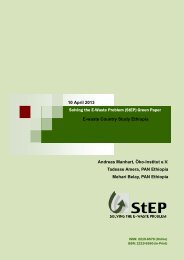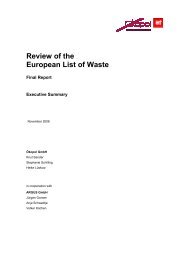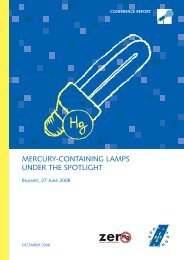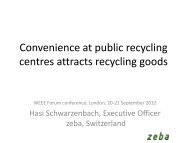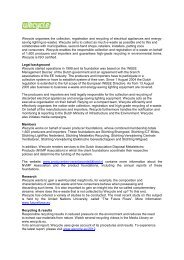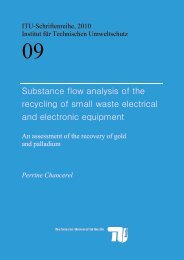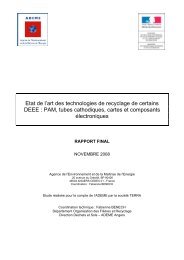by SENS and SWICO - Ecotic
by SENS and SWICO - Ecotic
by SENS and SWICO - Ecotic
You also want an ePaper? Increase the reach of your titles
YUMPU automatically turns print PDFs into web optimized ePapers that Google loves.
PCB’s in Small Capacitors from Waste Electrical <strong>and</strong> Electronic EquipmentsTable 6 Identifi ed individual substances <strong>and</strong> substance classes in the capacitor samplesN° Origin of Capacitors Possible Compounds / Substance ClassesLarge Household Appliances (LHA), Small Household Appliances (SHA)1 LHA mixture naphthalene, hydrocarbons, chlorinated naphthalene, phthalates2 Dishwashers naphthalene, hydrocarbons, biphenyls, chlorinated naphthalene,phthalates3 SHA mixture, without microwavedeviceshydrocarbons, methyl-naphthalene, chlorinated naphthalene4 Microwave devices biphenyls (for ex. ethyl methyl), phthalates5 Cooling <strong>and</strong> freezing appliances naphthalene, benzyl-methylbenzene, hydrocarbons, biphenyls,triphenyl phosphate, phthalates, phosphoric acid ester6 Ballasts in fl uorescent tube lamps phthalatesIT (Information Technology) / CE (Consumer Electronics) / UPS (uninterruptible power supply systems)7 IT / CE: capacitors < 1 cm hydroxybutyric acid, chloro-butyrophenon, phthalates, fatty acid,fatty acid ester, hexabrome benzene8 IT / CE: capacitors 1 –2.5 cm dimethylacetamide, hydroxybenzoic acid, benzyl alcohol, dimehylbenzylalcohol, dibenzoyloxy-heptane-diamide, benzoic acid ester,chlorinated naphthalene, carbonic acids, fatty acid ester, hexabromebenzene, phthalates, phosphoric acid ester9 IT / CE: capacitors > 2.5 cm Dimethyl acetamide, hydroxybutyric acid, methyl pirrolidon, benzoicacid chlorethyl ester, benzoic acid ester, tetrabutyl ammonium cyanide,butoxyethoxy-ethyl acetate, biphenyls, chlorinated naphthalene,phthalates10 UPS hydrocarbons3.4 GC-ECD / FID Fingerprint AnalysisBulk sample N° 4 “microwave devices” was submittedto a differentiated analysis, in order to enable, as muchas possible, more precise statements on the di-electrodes<strong>and</strong> electrolytes used after the PCB prohibition.The samples were prepared so as to allow individualidentifi cations within the substance classes, includingquantifi cation. Table 7 displays the results.Two signifi cant substance groups could be traced witha fi ngerprint measure <strong>by</strong> GC-ECD / FID: a technical mixtureof alkylated biphenyls <strong>and</strong> a technical mixture ofphthalates within DINP <strong>and</strong> DIDP range (di-isononylphthalate <strong>and</strong> di-isodecyl phthalate). The identifi cationof individual substances was not obvious <strong>and</strong> led toprobabilities in the laboratory report. But these areclearly technical mixtures as used in typical products forhigh-tension capacitors in microwave ovens (see paragraph4.3). With that, the results of the GC-MS full scananalysis could be asserted. The quantifi cation of thesemain components revealed that especially a very highamount of substituted biphenyls (18%) is found in capacitorsfrom microwave devices. In opposition, theamount of phthalates is situated in the per thous<strong>and</strong>range.Table 7 Quantifi cation of main components in capacitors from microwave devices (bulk sample Nº 4)Substance Group [ mg/kg ]Sum of biphenyls: (substituted <strong>by</strong> 4 methyl groups at most) 180’000Sum of DINP (di-isononyl phthalates) <strong>and</strong> DIDP (di-isodecyl phthalates) 2’15012



